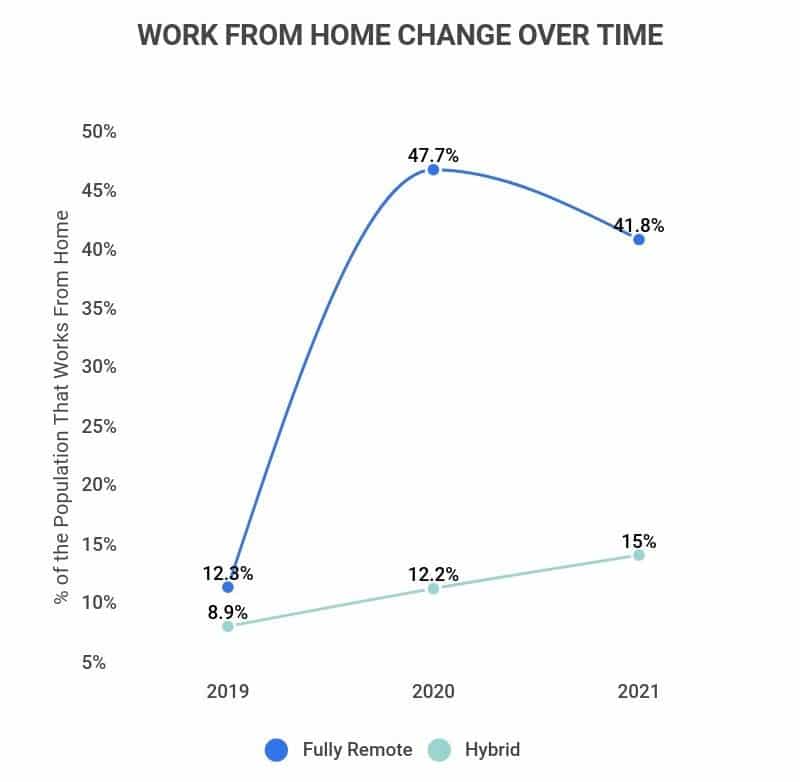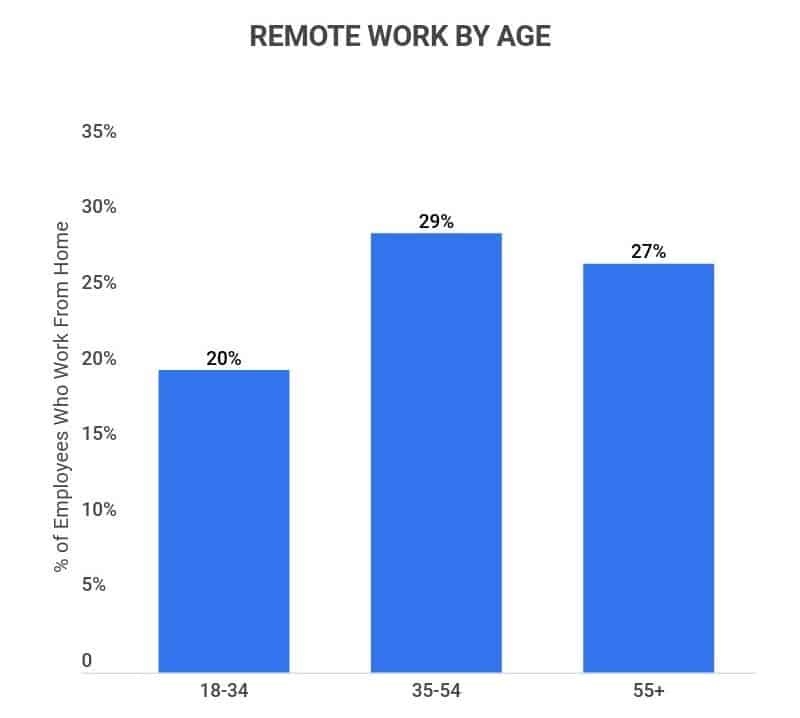Research Summary. Since the start of the COVID-19 pandemic, the amount of people working from home, voluntarily or involuntarily, has increased dramatically. Surprisingly, this change has increased productivity. According to our extensive research:
-
On average, workers are 13% more productive when working from home, and overall worker productivity in the U.S. has increased by 5% since the start of the pandemic.
-
40% of workers believe that they’ve been more productive while working at home during the pandemic instead of the office.
-
Choice and personal responsibility play a huge role in work from home productivity, as work from home employees perform 50% more activities through personal choice, and the number of tasks that could regularly be offloaded to others drops from 41% to 27%.
-
The average U.S. worker works 5.8 remote workdays per month, which is up by 2.4 since the start of the pandemic.
For further analysis, we broke down the data in the following ways:
Pandemic | Benefits | Drawbacks

General Work From Home Productivity Statistics
While working from home generally increases productivity, it’s important to dive into this in more detail. After all, there are differences between hybrid work from home employees, and fully remote employees, among other things. Here are the facts:
-
63% of high-revenue-growth companies enable hybrid work from home models.
As opposed to the 69% of negative or no-growth companies that haven’t adopted any work from home models, this suggests that implementing some form of remote work for employees is currently vital for company growth.
-
83% of workers surveyed prefer a hybrid work from home model.
This indicates that most workers prefer a system wherein they work from home at least 25% of the time.
-
Since 2000, the number of people working from home has increased by almost 4 million.
From 2000 to 2017, the number of people working from home has increased by 3.3%. While this might not seem like a lot, that’s an increase from 3.7 million to 6.5 million work-from-home employees.
-
16% of companies are fully remote.
Which is still small compared to the 44% of companies that don’t allow remote work. However, this trend changes over time, as 59% of workers report being more likely to choose an employer that allows remote work rather than one that doesn’t. Even further, 23% would take a 10% pay cut to work from home indefinitely.

Work From Home Productivity Pandemic Statistics
Because many people began working from home due to the COVID-19 pandemic, it’s worth noting the changes in productivity pre-pandemic until now. In fact, while many businesses have suffered, those who’ve transitioned to work from home have seen higher productivity. Here are some insights our research uncovered:
-
In 2020, 26% of employees worked entirely from home.
With the highest demographics of those working from home being women and college graduates, at 35% and 38% respectively. By contrast, only 17% of those without a college degree have worked from home during the COVID-19 pandemic.
-
In the last 5 years, the number of people working from home has increased by 44%.
Before the pandemic, the number of people working from home was only around 3.4% of the population. However, now the number of employees who work from home is up to 1 out of 4, or roughly 25%.
-
Experts predict that there will be 36.2 million Americans working remotely by 2025.
Which is an 87% increase from pre-pandemic levels, where there were only 7 million people working remotely.
-
The overall value of home production activities increased by $26.5 billion during the COVID-19 pandemic.
This includes tasks like Cooking, cleaning, caring for children, shopping, gardening, and more. Surprisingly, the amount of money made from these activities during the height of the pandemic was about 9.1% of the $292.6 billion drop in GDP.


Work From Home Productivity Benefits
As shown thus far, working from home comes with the benefit of higher worker satisfaction and productivity. With that in mind, what other benefits come from working remotely? According to our research:
-
Since the start of the COVID-19 pandemic, American workers have saved roughly 62.5 million hours per workday.
That’s an average of 54 minutes per worker and means that those working from home spent at least 35% of that saved time on their jobs.
-
In the United States, remote workers avoid emitting 3.6 million tons of greenhouse gasses every year.
That’s equivalent to planting 91 million trees! Most of these numbers come from commuting, as 86% of American commuters rely on private transportation, and transportation accounts for 29% of greenhouse gas emissions in the U.S.
Fewer vehicles on the road have also contributed to higher air quality, as 35% of the nitrogen dioxide emitted in the U.S. comes from highway vehicles.
-
Turnover reduces by 50% when employees have access to a work from home option.
This can largely be attributed to the other positive factors mentioned and workers feeling as though they have more adjacency, retention, and creativity in a work-from-home environment.
-
When employees can work from home, their performance increases by 22%.
And workers are aware of this, as 94% of them report feeling like their work productivity was the same or higher than when they didn’t work from home.
-
Despite working 43% more hours on average, work-from-home employees are 25% less stressed.
Part of this is due to the ability to maintain a better work-life balance and eat healthier. Less time devoted to commuting and more to the family is usually a positive.
Work From Home Productivity Drawbacks
Of course, every positive has to come with a few negatives, and work from home productivity is no exception. Most of these drawbacks come from isolation, distractions, and overworking. Here’s what we found:
-
Over 40% of those who work from home struggle with concentration and household distractions.
For instance, many find it difficult to separate their families or other members of their household from work. Surveys show that 48% of respondents found that children or family members demanding attention were a huge issue. After all, it can be difficult to separate work from the family in your own home.
-
30% of work from home employees have no access to important office equipment.
This includes things like laptops, printers, fax machines, and more. Plus, 20% of remote employees also report having no access to sensitive company documents.
-
Bad posture was reported by 23% of work-from-home employees.
Having an appropriate workspace and exercising can be a real struggle for work-from-home employees. 25% say that they don’t have a proper workspace, which can hinder posture and productivity. On top of that, the isolation that comes from staying cooped up in the house can lead to a lack of exercise.
-
19% of work-from-home employees stated “Isolation” as their #1 problem.
In fact, 1/2 individuals reported feeling lonely at least once per week, and 70% felt left out of their workplace.



Work From Home Productivity FAQ
-
Are workers more productive working from home?
In general, yes, workers are more productive when working from home. In fact, workers are 13% more productive when working from home, and overall worker productivity in the U.S. has increased by 5% since the start of the pandemic.
-
How can I be more productive working from home?
Some of the great ways you can combat working from home disadvantages and become more productive working from home are to:
-
Create a comfortable space dedicated to working.
-
Plan out a schedule, even if you aren’t required to.
-
Be aware of your distractions and do what you can to avoid them.
-
Find an hour to two hours of time when you flow best to dedicate to your work and nothing else.
-
Get dressed and take care of yourself to give yourself motivation.
-
Know when you take a break or a nap, so you don’t overwork yourself.
-
-
How do you measure employee productivity when working from home?
You can measure employee productivity when working from home by setting up clear performance goals, increasing communication, and using project or time trackers.
Having clear goals set up for each employee, project, or task is the first and best way to track remote employees’ productivity. This requires planning on your part, but it will result in increased independence for your workers and a better feel for their productivity levels for you.
When you do this, make sure you lay out specific dates and times and the tangible deliverables you expect to see at those points. This requires excellent communication, which is also vital to measuring employee productivity when working from home.
Set up clear communication channels and expectations, and be proactive about using them so that your employees get comfortable using them as well. This allows you to get a better handle on what everyone’s working on than you’d have if you only talked to your team once a week.
Finally, using a project or time tracking program can be an effective way to measure remote employees’ productivity. Using it to micromanage or watch them won’t help, but providing practical tools that allow the whole team to see a project’s progress and individuals to track their tasks can be valuable to everyone.
-
How can I monitor my work-from-home performance?
You can monitor your work-from-home performance by tracking how you spend your time each day and how many tasks you accomplish.
Whether you do it manually or with an automatic tracker, log how you spend your time working to see how well you’re focusing. You can do this every day, or you can do it for a few days to get a baseline and then check in on yourself every once in a while after that. Whatever method you choose, use the data you gather to set productivity goals for yourself.
In addition to this, you can track your work-from-home performance by recording the tasks you accomplish. This doesn’t just mean crossing off your daily to-dos; it means setting consistent goals or deadlines for yourself and then recording the steps you’ve taken to meet them.
That way, if you aren’t able to meet them, you can look back and figure out why, whether that was because something out of your control fell apart or you just weren’t as focused that month.
-
Are remote workers happier?
Yes, remote workers are often happier. When employees have the option to work from home, companies see their turnover rates shrink by 50%. This is widely attributed to workers’ enjoying the flexibility and creativity that comes from working from home.
In addition, employees’ performance increases by 22% when they’re able to work from home, with 94% of remote workers saying that they feel like their productivity stayed the same or increased when they worked from home. Remote employees are also 25% less stressed, even though they often work more hours than their in-person counterparts.
This is often chalked up to these employees’ increased ability to live a healthy lifestyle – they can make healthy, home-cooked meals and take a break to exercise during the day and spend more time with family instead of on a stressful commute.
Conclusion
Due to the COVID-19 pandemic, working from home is now more common than ever. As of 2020, 26% of employees worked entirely from home, which has increased overall worker productivity in the U.S. by 5%.
In fact, work from home employees are typically 13% more productive, 25% less stressed, and perform 22% better than their office counterparts. Not only that, but the lack of commuting has also saved the collective workforce 62.5 million hours per workday. No wonder there’s an increase in productivity.
Of course, isolation does continue to be an issue, as 19% reported it as being the disadvantage they struggle with the most.
Overall, though, the statistics show that working from home is more productive and often more beneficial than working in an office.
Sources:
-
Harvard Business Review. “Research: Knowledge Workers Are More Productive from Home.” Accessed on September 10th, 2021.
-
CBR. “Are we really more productive working from home?” Accessed on September 10th, 2021
-
Gallup. “U.S. Remote Workdays Have Doubled During Pandemic.” Accessed on September 10th, 2021.
-
Forbes. “Remote Work Evolves Into Hybrid Work And Productivity Rises, The Data Shows.” Accessed on September 10th, 2021.
-
United States Census Bureau. “2017 ACS 1-year Estimates.” Accessed on September 10th, 2021.
-
Owl Labs. “State of Remote Work.” Accessed on September 10th, 2021.
-
CNBC. “1 in 4 Americans will be working remotely in 2021, Upwork survey reveals.” Accessed on September 12th, 2021.
-
Federal Reserve Bank. “Home Production Activity during the COVID-19 Shutdown.” Accessed on September 12th, 2021.
-
EPA. “Sources of Greenhouse Gas Emissions.” Accessed on September 13th, 2021.
-
wbur. “Productivity, Retention And Cost Savings: Why Working From Home Benefits Employees And Employers.” Accessed on September 13th, 2021.
-
Stanford Graduate School of Business. “Does Working from Home Work? Evidence from a Chinese Experiment.” Accessed on September 13th, 2021.
-
Monster. “Working from home can benefit employers as much as employees.” Accessed on September 13th, 2021.
-
The Balance Small Business. “Disadvantages of Working From Home.” Accessed on September 13th, 2021.
-
Bit.Ai Blog. “Combating Social Isolation in Remote Working.” Accessed on September 13th, 2021.





